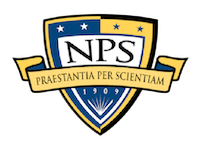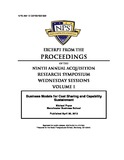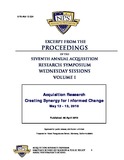Business Models for Cost Sharing and Capability Sustainment
Abstract
Cost sharing in defense acquisition, with contractors sharing part of the burden of research, development, test, and evaluation (RDT&E) costs, has been suggested as a way of reducing the liability of governments to program cost overruns. While capping the costs of RDT&E and production is an excellent objective, incentivizing contractors may benefit from business models that span the entire lifecycle of a program. The potential to share the risk of cost overruns outside of RDT&E and production, and into the operations and support (O&S) area, provides a powerful incentive to get contractors to ''buy in'' to cost sharing, and to control total program lifecycle costs. The research presented in this paper aims to develop new business models that allow contractors to benefit from cost sharing across all stages of program lifecycles, with a view to limiting costs during RDT&E, production, and O&S. Experience from the United Kingdom on availability contracting shows possible business models that could form the basis of an approach to cost sharing in O&S, as well as the weaknesses of some approaches tried. A set of case studies form the basis for the findings of the research. These use the concept of complexity and interactions as outlined in prior research (Pryce, 2011), and relate this complexity to the way that current business models and contracts for development, production, and support have been structured. It also looks at how the business models and contracts might have been written if a long-term approach, across the lifecycle, had been taken into account. The results of the case studies will provide a matrix of findings for the research, from which a set of ideal business models will be derived. These ideal business models will then be reviewed in light of the experiences of commercial organizations engaged in similar programs. In this paper initial, empirical business models are described as a basis for discussion, ahead of the final report of the research.
Description
Proceedings Paper (for Acquisition Research Program)
NPS Report Number
NPS-AM-12-C9P09R02-062Related items
Showing items related by title, author, creator and subject.
-
Contractor Incentives for Success in Implementing Performance-Based Logistics: A Progress Report
Gupta, Jatinder (Jeet) N.D.; Eagan, Michael C.; Jones, Joshua N.; Piatt, James C. (Monterey, California. Naval Postgraduate School, 2010-04-30); NPS-AM-10-034In implementing performance-based logistics (PBL), the need for several resources like inventory investment decreases. Therefore, the contractor''s profit, which was based on the level of these resources, may decrease. ... -
Using Additive Manufacturing to Mitigate the Risks of Limited Key Ship Components of the Zumwalt-Class Destroyer
Wang, Xiao Y.; Whitworth, James R. (Monterey, California. Naval Postgraduate School, 2017-03); SYM-AM-17-073The purpose of this project was to explore the benefits of using a combination of additive manufacturing (AM), performance-based logistics (PBL), and open systems architecture (OSA) to mitigate the risks of limited key ... -
Using Additive Manufacturing to Mitigate the Risks of Limited Key Ship Components of the Zumwalt-Class Destroyer
Wang, Xiao Y.; Whitworth, James R. (Monterey, California. Naval Postgraduate School, 2017-03); SYM-AM-17-136The purpose of this project was to explore the benefits of using a combination of additive manufacturing (AM), performance-based logistics (PBL), and open systems architecture (OSA) to mitigate the risks of limited key ...



 NPS-AM-12-C9P09R02-062.pdf (257.6Kb)
NPS-AM-12-C9P09R02-062.pdf (257.6Kb)

